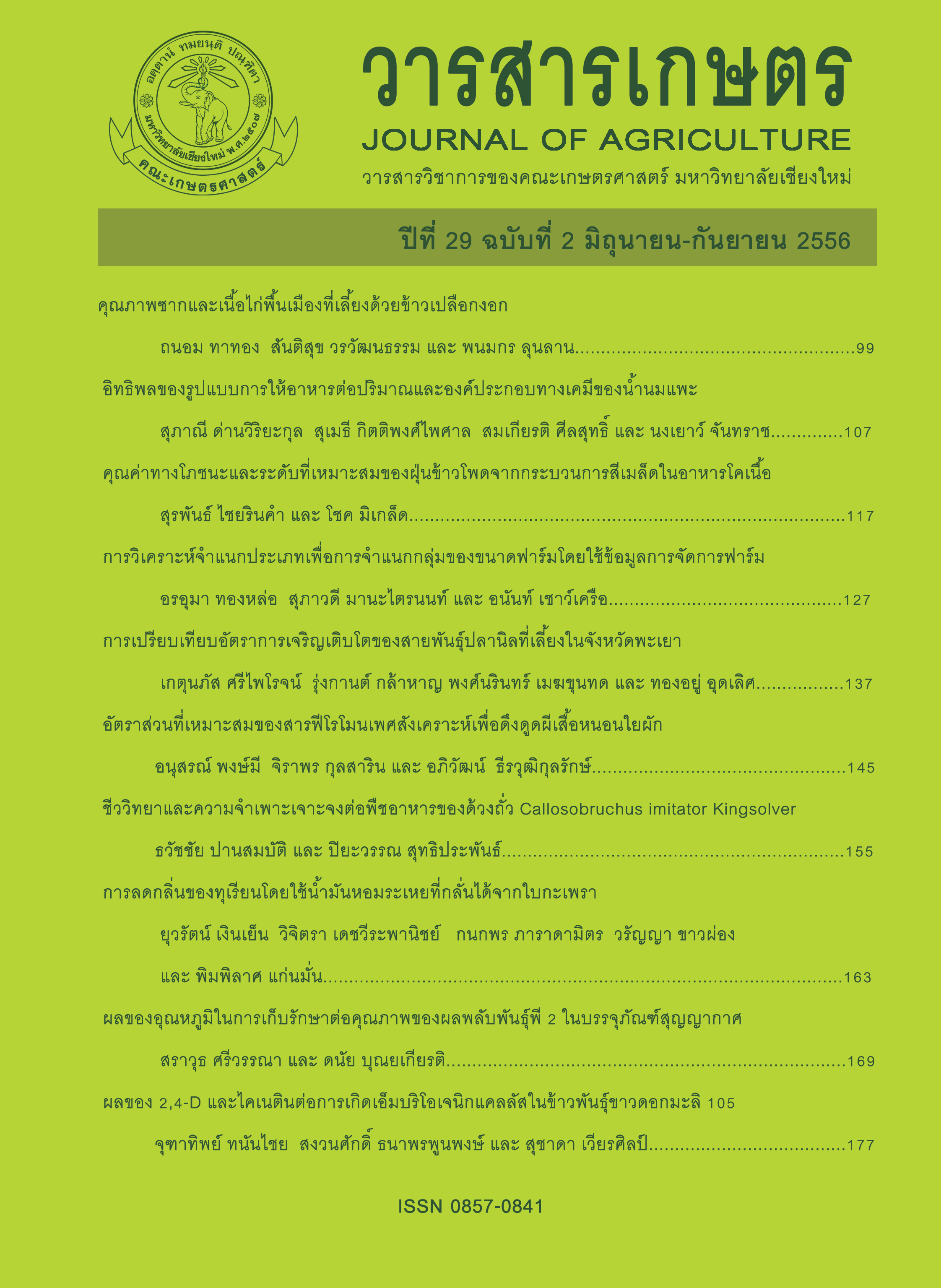อัตราส่วนที่เหมาะสมของสารฟีโรโมนเพศสังเคราะห์ เพื่อดึงดูดผีเสื้อหนอนใยผัก
Main Article Content
บทคัดย่อ
สารฟีโรโมนเพศของผีเสื้อหนอนใยผัก Plutella xylostella L. เมื่อวิเคราะห์ด้วย Gas chromatography (GC) และ GC-mass spectrometry (GC-MS) พบว่ามีสารประกอบคือ Z-11-hexadecenal (Z11-16 : Ald), Z-11-hexadecenyl acetate (Z11-16 : OAc) และ Z-11-hexadecen-1-ol (Z11-16 : OH) สารทั้ง 3 ชนิด สามารถสังเคราะห์ได้จากสาร 11-bromoundecanoic acid และนำมาทดลองในห้องปฏิบัติการโดยใช้อุโมงค์ลมจำลอง เพื่อหาอัตราส่วนที่เหมาะสมในการดึงดูดผีเสื้อหนอนใยผักเพศผู้ของสารฟีโรโมนสังเคราะห์ โดยเปรียบเทียบระหว่างอัตราส่วนผสมแบบ 2 ส่วนผสม (Z11-16 : Ald : Z11-16 : OAc) และอัตราส่วนผสม แบบ 3 ส่วนผสม (Z11-16 : Ald : Z11-16 : OAc : Z11-16 : OH) เพื่อดึงดูดผีเสื้อหนอนใยผักเพศผู้ในระยะเวลา 72 ชั่วโมง พบว่าสารฟีโรโมนสังเคราะห์แบบ 2 ส่วนผสม ไม่มีประสิทธิภาพในการดึงดูดผีเสื้อหนอนใยผักเพศผู้ ส่วนสารฟีโรโมนสังเคราะห์แบบ 3 ส่วนผสม ในอัตราส่วน 50 : 50 : 1 ปริมาณ 100 มิลลิกรัม สามารถดึงดูดผีเสื้อหนอนใยผักเพศผู้ได้ 41.50 ตัว ใกล้เคียงกับผลิตภัณฑ์ทางการค้าที่ดึงดูดผีเสื้อหนอนใยผักเพศผู้ได้ 42.00 ตัว ดังนั้นสารฟีโรโมนสังเคราะห์ในอัตราส่วน 50 : 50 : 1 จึงเป็นอัตราส่วนที่เหมาะสมของสารฟีโรโมนสังเคราะห์ที่ใช้ดึงดูดผีเสื้อหนอนใยผักเพศผู้และมีความสำคัญต่อการนำไปประยุกต์ใช้กับกับดักฟีโรโมนเพื่อการป้องกันกำจัดผีเสื้อหนอนใยผักต่อไปในอนาคต
Article Details
เอกสารอ้างอิง
จิราพร กุลสาริน และ อภิวัฒน์ ธีรวุฒิกุลรักษ์. 2553. รายงานฉบับสมบรูณ์ โครงการการวิจัยและพัฒนาผลิตภัณฑ์กับดักฟีโรโมนเพื่อควบคุมหนอนใยผักในการปลูกพืชตระกูลกะหล่ำบนที่สูง. สถาบันวิจัยและพัฒนาพื้นที่สูง (องค์การมหาชน). เชียงใหม่. 45 หน้า.
อัจฉราพร เกตุกระทุ่ม เกศรา จีระจรรยา และ สิริวัฒน์ วงษ์ศิริ. 2528. กับดักสารเพศของหนอนใยผัก. วารสารวิชาการเกษตร 3(3): 176-181.
Chow, Y. S., Y. M. Lin and C. L. Hsu. 1977. Sex pheromone of diamondback moth (Lepidoptera: Plutellidae). Bulletin of the Institute of Zoology Academia Sinica 16: 99-105.
Deng. J. Y., Y. P. Jiang, Z. G. Wang, J. X. Jiang and J. W. Du. 2007. Field behavioral response of male diamondback moth, Plutella xylostella to different components, ratios and dosages of synthetic sex attractant in China. Journal of Zhejiang University (Agric. & Life Sci.) 33(5): 514-518.
Lee, S., D. W. Lee and K. S. Boo. 2005. Sex pheromone composition of the diamondback moth, Plutella xylostella (L.) in Korea. Journal of Asia Pacific Entomology 8: 243-248.
Mayer, M. S. and E. R. Mitchell. 2001. Differences between attractive diamondback moth, Plutella xylostella (L.) (Lepidoptera: Plutellidae), sex pheromone lures are not determinable through analysis of emissions. Agricultural and Forest Entomology 1(3): 229-236.
Miller, J. R. and W. L. Roelofs. 1978. Sustained-flight tunnel for measuring insect responses to wind-borne sex pheromones. Journal of Chemical Ecology 4: 187-198.
Muirhead-Thomson, R.C. 1991. Trap Responses of Flying Insects. Academic Press Limited, New York. 287 p.
Reddy, G. P. V. and A. Guerrero. 2000. Behavioral responses of the diamondback moth, Plutella xylostella, to green leaf volatiles of Brassica oleracea subsp. capitata. Journal of Agricultural and Food Chemistry 48: 6025-6029.
Suckling, D. M. and G. Karg. 2000. Pheromones and other semiochemicals. pp. 63-100. In: J.E. Rechcigl and N. A. Rechcigl (eds.). Biological and Biotechnical Control of Insect Pests. CRC Press, Boca Raton, Florida.
Suckling, D. M. and G. M. Burnip. 1996. Orientation and mating disruption in Planotortrix octo using pheromone and inhibitor. Entomologia Experimentalis et Applicata 78: 149-158.
Tamaki, Y., K. Kawasaki, H. Yamada, T. Kashihara, N. Osaki, T. Ando, S. Yashida and H. Kakinohama. 1977. Z-11-hexadece-nal and Z-11-hexadecenyl acetate: Sex pheromone components of the diamondback moth (Lepidoptera: Plutellidae). Applied Entomology and Zoology 12: 208-210.
Talekar, N. S. and A. M. Shelton. 1993. Biology, ecology and management of diamond back moth. Annual Review of Entomology 38: 275-301.
Talekar, N. S., J. C. Yang and S. T. Lee. 1990. Annotated Bibliography of Diamondback Moth. Volume 2. AVRDC. Shanhua, Taiwan. 199 p.
Wang, X., V. Le, Y. Fang and Z. Zhang. 2004. Trap effect on the capture of Plutella xylostella (Lepidoptera: Plutellidae) with sex pheromone lures in cabbage fields in Vietnam. Applied Entomology and Zoology 39(2): 303-309.
Whalley, P. 1988. Butterfly & Moth. Dorling Kindersley in Association with Natural History Museum, London. 63 p.
Yang, C. Y., S. Lee, K. S. Choi, H. Y. Jeon and K. S. Boo. 2007. Sex pheromone production and response in Korean populations of the diamondback moth, Plutella xylostella. Entomologia Experimentalis et Applicata 124(3): 293-298.


